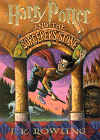
The buzz on this book was just too much for me, and I finally had to buy it and check it out. Although published at $18, chances are you can still pick this up for nearly half-price like I did, because it has been on the bestseller charts now for months and shows no sign of dropping. I wonder if this is like when The Hobbit hit the roof?
The series, of which this is the first book, centers on a young child named Harry Potter who loses his parents to the nefarious evil wizard Voldemort as a mere babe. Somehow Harry survives, and is marked by a lightning bolt on his forehead. A squadron of good wizards (the staff of Hogwarts School of Witchcraft and Wizardry) place the baby with his aunt and uncle and cousin, a group of “mundanes” named Dursley. The Dursleys are aware of Potter’s family heritage, but want to have nothing to do with it, so they neglect Harry, refusing to pass along the mail he receives from Hogwarts and basically making him a slave to his cousin. But, like all true Cinderella stories, the nasty step-family gets its comeuppance, and Harry learns that his life is charmed. That’s only the first third or so of the book–after that, things get real tough for Harry, as he has to attend the private (in England, public) school for wizards, without knowing the first thing about magic. There’s bullies, and mysterious teachers, and then there’s Voldemort and what he would really like to do to Harry.
Originally I compared this in my mind to Diana Wynne Jones, an English children’s fantasist that I only discovered a few years ago. But Jones writes for an older audience, and often her work has a dark streak in it that indicates that things sometimes go wrong. There’s nothing of that here–while suspenseful, the fun here is akin to that of Edward Eager, author of Half-Magic and other E. Nesbit-like books. How does the magic work, what are the limitations, and the learning experience of children are the themes of his books, and Rowling has taken this to heart.
This book deserves its accolades. A children’s book that contains enough moral underpinning without resorting to the sledgehammer, yet is fun and enjoyable. There’s not many things better than that.
[Finished July 1999]
